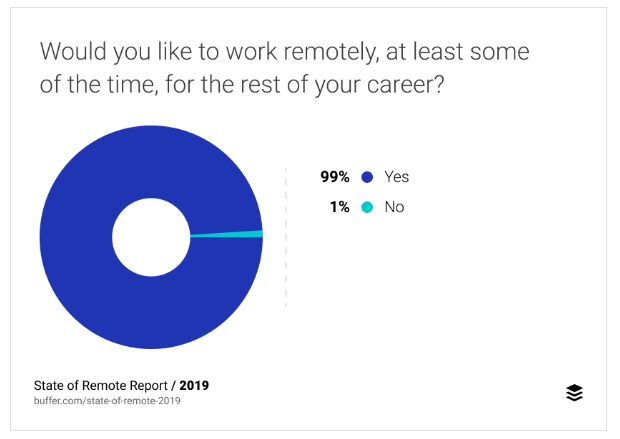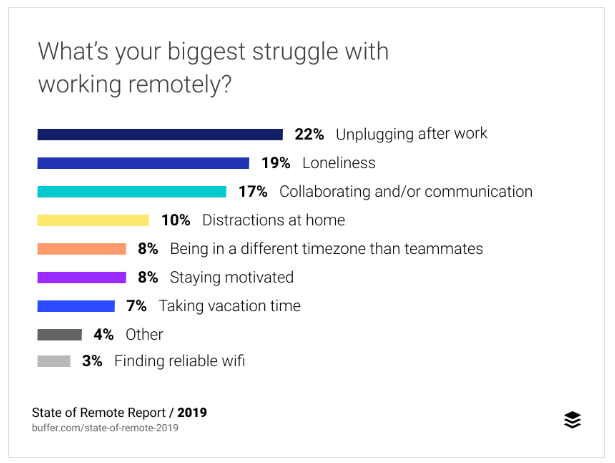With the ring of the alarm, you wake up from your slumber, rush to your bathroom, speed up your breakfast, get ready and…Switch your laptop, log in and start agile remote work. No going to the office, no meeting your colleagues, no direct confrontation with your bosses, no wearing the formal attire and obviously no stepping out of your homes. This has been the routine of the world for the past couple of weeks, and we do not know how long we will have to continue this. Is this the Future of Workforce? The future is uncertain due to the outbreak of the global pandemic, but we can see the remote working gaining popularity in the cross-sections of the organizations.
Various micro, small and medium enterprises (MSMEs), various large organizations and top gigs have started experimenting with the “Work from Home” (WFH) option due to the criticality of the situation. For maintaining social distancing and quarantine, the workforce has started operating remotely from their homes, but is it productive? Is it efficient? Is agile remote work a myth? The answer is YES and NO. Let’s see why I have answered both. Confusing? Not so much! Dive in!
The employees, who are serious and efficient in the workplace, will continue to remain the same even if they are working from home. While some, who remain busy in finding a chance to get away with the work will also continue to be same at homes. “Work from Home” ideally means to remain productive and efficient, only the job location is not the corporate office but your living or bedroom. But the world is not Utopia, so the definition is often modified and changed as per the will of the employees. The gig ecosystem and startups often permit the employees to choose flexible engagement models. Flexible and cooperative work culture often boosts encouragement and efficiency among workers. But again, there are certain organizations that follow traditional work culture, and to them, the WFH is a new concept. They are compelled to experiment with the new concept by the present outbreak of coronavirus.

Micromanagement is essential, but to what extent? No one is a nursery kid here that they will need a class teacher to monitor their every action. There are ways by which the organizations can retain a collaborative and productive work culture in the process of encouraging agile remote work. Many believe that remote working and agility cannot go hand in hand. Is it so?
As per Chicago Tribune, “What many organizations learn from the experience is that a remote work program, when approached strategically, can deliver far greater organization benefits such as improved (talent) attraction and retention, increased productivity and engagement, reduced real estate costs and environmental impact and more.” Whether the feedback of the employers and employees are positive regarding WFH will determine the longevity of the pandemic-driven dive into the genre of remote working.
According to Gallup Research, remote working can be highly productive and efficient. It says, “Remote work is on the rise. The number of hours spent working off-site is increasing, as is the number of workers. In 2012, Gallup data showed 39% of employees worked remotely in some capacity, meaning they spent at least some of their time working away from their coworkers. In 2016, that number had grown four percentage points to 43%. And of those who do work remotely some of the time, the percentage of time spent working remotely increased from 2012 to 2016 as well. The Society for Human Resource Management (SHRM) found a threefold increase in the number of companies offering remote work options between 1996 and 2016.”
As reported by McKinsey & Company, “Protect your employees. The COVID-19 crisis has been emotionally challenging for many people, changing day-to-day life in unprecedented ways. For companies, business, as usual, is not an option. They can start by drawing up and executing a plan to support employees that is consistent with the most conservative guidelines that might apply and has trigger points for policy changes. Some companies are actively benchmarking their efforts against others to determine the right policies and levels of support for their people. Leaders must communicate with employees with the right level of specificity and frequency.”
How can organizations retain productivity and agility in Remote working? The organizations can unlock the growth potential of the employees in Remote Working, by taking some valuable steps.
Agile Remote Work Needs Effective Communication
There are many employees who enjoy socializing, going to the office, discuss and vent out to colleagues etc. In remote working, they may feel lonely and discouraged at times. They have to work at homes alone, without anyone to talk to regarding work-related topics. In such cases, the organizations can initiate group conversations where employees can communicate both formally and informally. Provide some guidelines regarding video call best practices, especially to those who are new to the technology. Maintaining a group calls etiquette will allow all the employees to give their opinions and views. A conversation facilitator can be nominated while teleconference with large groups, so that everyone gets their fair share of opportunity to speak up. Allowing breaks during prolonged meetings and keeping the virtual meeting short and precise, and encouraging virtual coffee breaks for discussion of non-work topics can preserve a healthy and communicative work culture.

Be Empathetic for Fostering Agile Remote Work
The employees will be working from their homes, which is a highly informal space. The chatter of TV, the sound of a pressure cooker, the scream of a child, power cuts, internet problems etc are normal in the home space. Even the managers are not immune to these problems. The organizations have to be empathetic towards the conditions in which the employees are present. For example, the working mother is busy in a videoconference on Zoom, and her 5 years old daughter, who hardly gets to meet her mother generally, comes to her and shows her new painting. These kinds of situations must be excused. It depends on the employees how they will tackle such situations. It depends on the mother how she will explain to her daughter to go back to her room and continue painting.
Foster a Culture of Recognition
The work culture has now shifted towards employee-centric from employer centric, as studied by Deloitte. The employees are physically disconnected and geographically distributed. The tradition of recognition and enjoying moments of small wins impart a positive work culture. Word like “Thanks”, “Well Done”, “Congratulations” encourage the employees to retain agility in remote working. Encouraging peer-to-peer recognition and also from managers is an effective method to aid employee engagements. Foster agile remote working in the process of building a culture of recognition.
Hold Routine Virtual Training Sessions
By training, I mean both for professional and personal well being. The organizations can hold virtual training sessions, webinars, and virtual tutorials, provide study materials online, like documents, eBooks, pdf files, etc. The contagion must not halt the employee training sessions. Tools like Zoom enable webinars, video conferencing and also allow one-on-one discussions. In 2020, the share price of Zoom has increased to a whopping 67%. Effective virtual training sessions can make the remote workforce productive. Some employees can find difficulties in getting accustomed to the new model of remote working. Some can feign working and engage in unnecessary procrastination. Some may engage in social media sites instead of working actually. Some may lack the motivation to get out of their mattresses. The organizations can encourage the employees to use self-assessment tools and develop personal insights. Short and focused training sessions can be targeted towards their personal well being and boosting motivation.
Advise the Employees to Set Up a Dedicated Workspace
Sitting on the bed for long hours, or sitting at the dining table which is the situation in the common area of the house can often hamper productivity. A dedicated workspace must be assigned for successful work execution. The organizations often provide official laptops and tablets to their employees for completing office work at homes. They can go an extra mile and give their employees noise cancellation headsets and detachable mouse and keyboards. These kinds of gestures often motivate employees. The employees then tend to believe that the authorities are concerned about their well being. The employees can blur their backgrounds while video conferencing, for example, Skype has a similar feature. Educate the employees about the correct sitting posture and the working hours. The working hours must be devoted to the official purpose solely, and the employees must not deviate during these hours.

Final Takeaways
Several organizations are coming up with new technologies to sustain the sudden hike of agile remote work, which is the need of the hour. Practising social distancing has helped mankind to prevent the transmission of the contagion, but at the same time added some challenges to this new genre of work culture. Reimbursing the internet charges, partially reimbursing the electricity charges, as now people are compelled to stay at home for longer home, ensuring the security of the information shared in cases like where the employees are living in shared arrangements, like in PG or with flatmates. While the challenges are sure to exist, technology is doing its share of activities to boost agile remote work.

As stated by IBM, “IBM is helping customers maintain business continuity by eliminating the cost of using the Aspera on Cloud service for high-speed file sharing and team collaboration. This hosted service includes built-in security and allows users located anywhere to fully utilize their available bandwidth to exchange large files and data sets quickly and reliably. As a fully hosted SaaS, there is no infrastructure to deploy and no special networks to configure, employees can immediately start sending, receiving and sharing files of any size securely over the public Internet.”
Several technological tools are being developed for ensuring seamless face to face conversations even while social distancing, for example, Skype, WhatsApp, Slack, BlueJeans, Zoom, Webex, Sococo, Google Duo etc. According to Gartner Research, organizations can increase retention rates by 10% by permitting remote work culture. As per Aron McEwan, the Vice President of Gartner, “Remote-work success depends heavily on whether you trust employees to do their work even if you can’t see them.” He also adds that “When the dust settles, we’ll likely see that our remotely working employees were just as productive during this crisis — if not more so,”
Though many are getting introduced to the concept of remote working since the outbreak of contagion, several researchers and experts have predicted the continuation of the trend in the coming years.
The Future of Work is getting shaped by the higher incorporation of the genre of agile remote work. While many organizations are well accustomed to these work arrangements, several are getting introduced to it. The contagion is wreaking havoc with an increasing number of patients and casualties. Judging by the uncertainty of the situations, Remote Working is all set to grab the dominance and will probably continue in the coming years.

